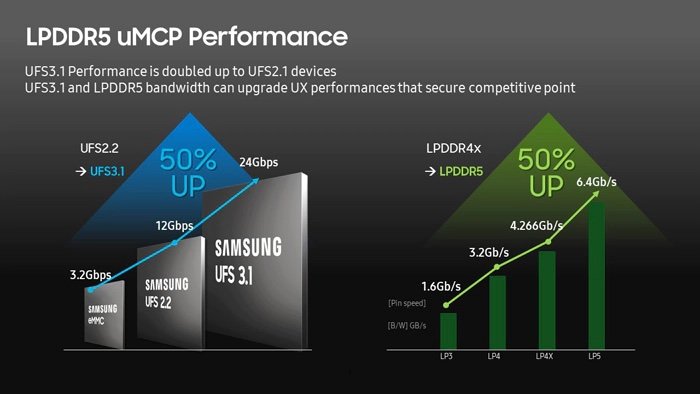www.electronics-usa.com
18
'21
Written on Modified on
Samsung News
5G for all – LPDDR5 uMCP opening up next-generation smartphone
LPDDR5 uMCP is giving the performance boost needed as high and mid-range smartphones enter the 5G space.

Initially considered a niche pursuit for early adopters, 5G is now being used by more everyday consumers who appreciate the benefits it delivers to them. The number of 5G mobile subscriptions worldwide is forecast to exceed 2.7 billion by 2025 and as such, Samsung expects to see an increase in high and mid-range 5G handsets. The company’s forecast data points towards expansion in these smartphone classes taking place this year and next, when compared with 2020.
Gaining this level of critical mass will require 5G capabilities in a broad range of devices – not just flagships. As such, memory solutions will have to follow suit in order to give a fast, next-generation experience to all who require it. The industry needs to develop high density memory solutions that reflect market demands, user expectations and operating system requirements.
Looking at the demand for DRAM and NAND in smartphones, forecasts from Samsung point to an increase here too, particularly at the highest densities. Smartphones with 8-12 GB DRAM are increasing, and will continue to do so for the remainder of 2021. Demand for 12 GB smartphones in particular was minute in 2019. A similar trend can be seen with 128-512 GB NAND. Within this higher range, we’re likely to see growth continuing this year and next. And with increasing demand for high end memory in small, yet powerful devices, comes new levels of innovation.
5G technology doesn’t just require incremental improvements, it calls for completely new functionality that wasn’t possible before. It therefore needs bigger jumps in the semiconductor technology capability so that devices can be connected to each other in new ways, with high data speeds, low latency and better availability.
Doubling up on performance
A transformative memory technology used in smartphones is UFS3.1 with LPDDR5. There’s been an increase in high-end products using UFS3.1 with LPDDR5 over the past year, and mid-range products are also using it increasingly too. UFS3.1 with LPDDR5 is a leading uMCP solution, which combines a mobile DRAM and NAND into a single package. Increased implementation of this generation of uMCP among mid-tier smartphones is important because of what it represents in terms of performance improvements.
The performance of USF3.1 and LPDDR5, which are contained within this generation of uMCP, show an increase when compared with previous generations. The sixth generation V-NAND 256 GB UFS3.1 shows a 100% improvement leap, going from 12Gbps in UFS 2.2 to 24Gbps now. The 10nm-class 12Gb LPDDR5 delivers a data rate of 6.4Gbps - approximately 50% faster than the LPDDR4X, 4.2Gbps mobile memory in today’s flagship smartphones. The enhancements within the LPDDR5 uMCP are clear and as such, benchmark score improvement when compared with the last generation.
If this amount of power is being rolled out in more devices, it’s a triumph for the technology itself and a win for consumers. By placing a high performing mobile DRAM and NAND in one package, high and mid-range products show a similar level of performance as flagship products. This results in more intelligent smartphones at multiple price points. Smartphone makers can now maximize the potential of Samsung LPDDR5 uMCP in devices that feature more than five cameras and ever-increasing display sizes, as well as artificial intelligence and 5G capabilities.
Samsung has been recognized within the industry for this work that is putting cutting edge technology in people’s pockets. Samsung LPDDR5 uMCP was among 44 products from the company that received CES 2021 Innovation Awards. The prestigious awards recognize outstanding design and engineering in cutting-edge technology. Samsung LPDDR5 uMCP sits alongside the leading SSD and smartphone products as examples of the way Samsung develops groundbreaking innovation that moves the industry and society forwards.
Smartphone memory progression
From the uMCP solutions that became available and were used in high-end smartphones in 2017, smartphone performance has been improving all the time. uMCP is still used in some devices and market analyst Counterpoint suggests that we’re currently seeing uMCP become the favored solution due to the fact that it can read and write at the same time. We’re now progressing through uMCP solutions, including UFS 2.2 and LPDDR4X in 2019, and UFS3.1 and LPDDR5 in 2021. Performance is hitting a new peak as each stage progresses. As such, benefits such as 4K and 6K displays for high resolution gaming, and seamless multitasking can be expected on more mobile devices.
Shipments of 5G enabled smartphones will reach 51.4% by 2023, overtaking 4G shipments. As such, the industry is in a critical time as it prepares for as many devices as possible to feature the technology. The latest generation of uMCP is a major contributor to the success of this move forward.
www.samsung.com

